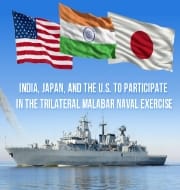Malabar 2018: India, Japan and US start naval exercise off coast of Guam Island in western Pacific
Trilateral Naval Exercise Malabar 2018 between India, Japan and United States kicked off the coast of Guam in Philippine Sea. It will be 22nd edition of the naval exercise, which has now become an annual feature in deep military ties between India and US. It will be first naval wargame after US renamed its Hawaii-based Pacific command (PACOM) as Indo-Pacific Command (INDOPACOM) amid increased Chinese activities of building artificial islands in South China Sea and sending submarines into Indian Ocean.
Key Facts
This edition of annual exercise will focus on high-end war fighting skillsets, subject matter expert and professional exchanges. It will also include combined carrier strike group operations, surface and anti-submarine warfare, medical operations, maritime patrol and reconnaissance operations, damage control, helicopter operations and visit, board, search and seizure operations.
Phases: Malabar 2018 will be conducted in two phases: ashore and at-sea training. The harbour phrase will take place at Naval Base Guam and sea phase in Philippine Sea.
The ashore phase in Guam will include subject matter expert and professional exchanges on carrier strike group operations, reconnaissance operations, maritime patrol, surface and anti-submarine warfare, medical operations, damage control, helicopter operations and visit, board, search and seizure (VBSS) operations.
The sea phase will see military-to-military coordination and capacity to plan and execute tactical operations between three navies in multinational environment. It will also see events like gunnery exercises, anti-submarine warfare, air defence exercises, surface warfare exercises, helicopter cross-deck evolutions and underway replenishments.
Participation: US Navy has deployed aircraft carrier USS Ronald Reagan, guided-missile cruisers USS Antietam and USS Chancellorsville, guided-missile destroyer USS Benfold and P-8A Poseidon aircraft. Indian Navy has deployed INS Kamorta, the first of four anti-submarine Kamorta-class stealth corvettes; INS Sahyadri, Shivalik-class stealth multi-role frigate, Deepak-class fleet tanker INS Shakti and also P-8I Neptune advanced maritime patrol and anti-submarine warfare aircraft. Japan Maritime Self Defense Force (JMSDF) has deployed three ships 19,000-tonne JS Hyuga (lead ship of Hyuga-class of helicopter carriers), Takanami-class guided-missile/ASW destroyer JS Suzunami, Akizuki-class guided-missile destroyer JS Fuyuzuki and diesel-electric attack submarine and Kawasaki P-1 maritime patrol aircraft..
Background
The Malabar exercise was started in 1992 as joint Indo-US naval drill. Since then it is held annually.But it was suspended from 1998 to 2002 after India conducted nuclear weapons tests in 1998. Japan became permanent participant in 2015.
The primary aim of this multilateral exercise is to increase interoperability amongst navies of three countries and develop common understanding of procedures for Maritime Security Operations and deepen defence relations between them.
In 2007, the exercise also saw participation of Australia and Singapore. All the participating nations in the exercise have clarified earlier that Malabar series of exercise is not aimed against specific country Since last two years, Australia repeatedly requested to be part of annual exercise but India again refused after China raised is concerns.
Month: Current Affairs - June, 2018


